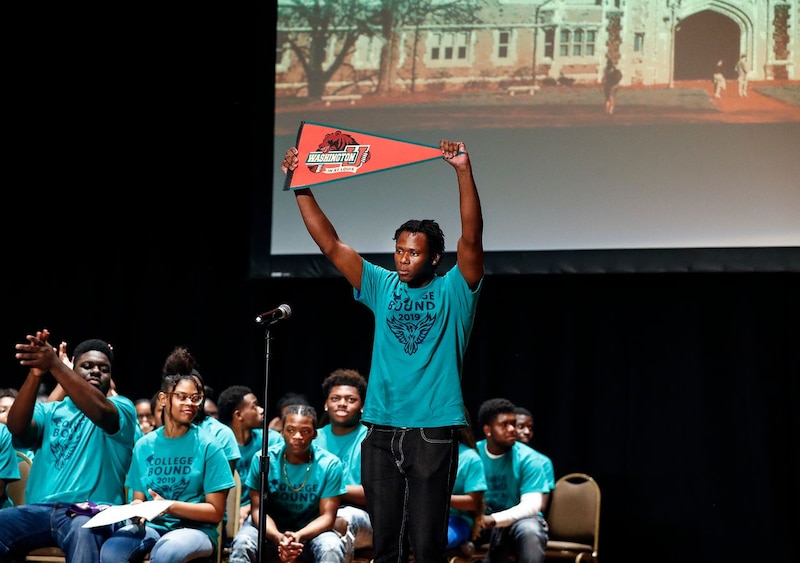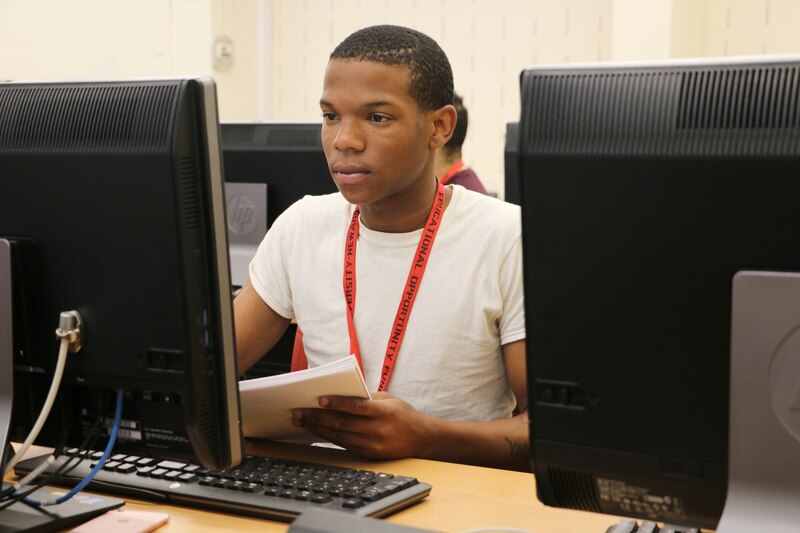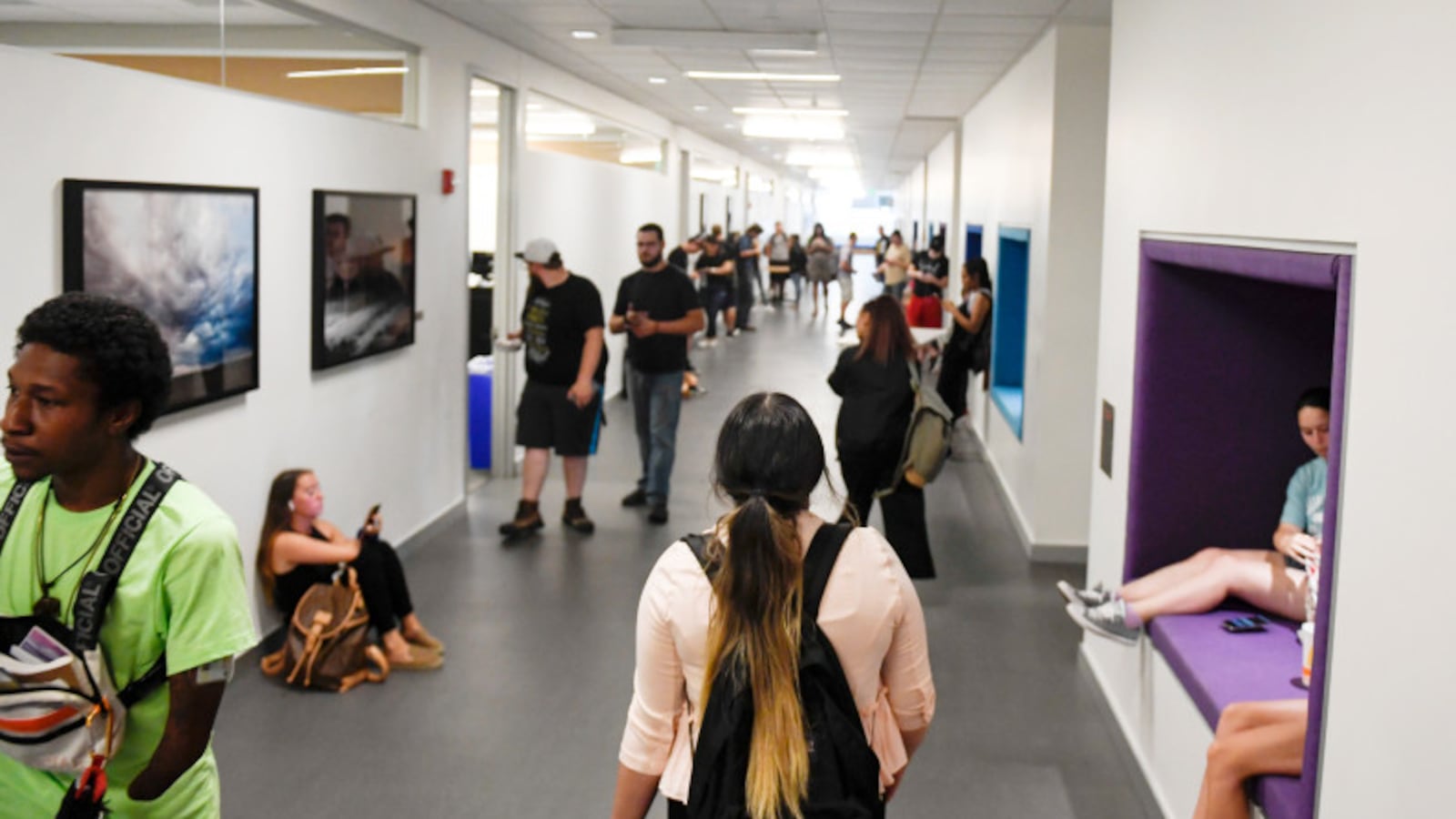Getting to college is just the beginning of the challenge for America’s students looking to earn a degree.
About 40 percent of students who enroll in college for the first time won’t have a degree six years later, the latest data show. And the disparities here are striking: While two-thirds of white students who start college finish a degree in that time, only about 40 percent of black students and 50 percent of Hispanic students do. Students from more affluent families are also much more likely to earn a degree than students from low-income families.
These differences reflect the many barriers low-income students of color face in making it through college.
Chalkbeat has been examining those challenges in our Ready or Not series, which has highlighted how students’ K-12 schools and their colleges often fall short in preparing and supporting students — and how some schools are trying to close those gaps.
Some research provides other reasons for optimism. Studies show that certain policies, particularly tuition grants paired with intensive, in-college support, can substantially raise low-income students’ chances of completing college.
“The interventions that seem to yield the best success provide unified supports — the kinds of systems of support that may provide students financial aid but that also attend to the other structural barriers that students face, or the guidance and help they need in terms of how to organize their courses and organize their time,” said Lindsay Page, a professor at the University of Pittsburgh.
We’ve combed through dozens of studies to try to pin down what else we know about what’s working — and what isn’t — to help students make it to and through college. Here’s a rundown.
What helps: More and better high school counseling
Students who had a particularly good high school counselor were 1.5 percentage points more likely to attend college and 1.4 points more likely to stay in college through their first year, according to a recent Massachusetts study. Counselor diversity matters too: students of color were about 2 points more likely to attend and persist in college if they had a counselor of color.
Simply hiring more counselors can also help. One study found that hiring an additional college counselor led to a large jump in four-year college enrollment.
Research on other college advising and support initiatives — like programs designed to increase students’ interest in college or offer support through the application process — is mixed. Some have demonstrated clearly positive results, but others have had limited or mixed effects. Recent studies on virtual counselors, who communicate with students by video, phone, and email, show they have little if any impact.
What helps: Grants for college — usually
It’s clear that students and their families think about finances when enrolling in college — and more financial aid through grants (as opposed to loans) generally means higher rates of college enrollment, persistence, and completion.
Our best estimate of how much of a difference this can make: Every $1,000 in grants translates into a 1.5 to 2 percentage point increase in degree completion, according to an overview of 43 studies.
“Students would experience worse outcomes without this investment,” the researchers concluded.
Specifically, studies have found students benefit from state financial aid programs in California, Florida, Texas, and West Virginia, as well as programs that promise to pay tuition for public school graduates in cities like Kalamazoo, Michigan; Buffalo, New York; and Pittsburgh
Here’s another way to show the impact of financial considerations: research has found that fluctuations in families’ housing values — a measure of wealth — affect where students go to and whether they complete college.
There are some exceptions. For example, neither a merit-aid program in Milwaukee nor a “free college” initiative in New York had any effect on college enrollment. A need-based private scholarship program in Wisconsin failed to improve college completion.
Simplicity seems to be a key design feature. A recent study tested what happened when low-income, high-achieving high schoolers in Michigan were sent a letter offering them a full-tuition scholarship to the University of Michigan.
Those students’ likelihood of enrolling at the school jumped by 15 points; without the letter some of them wouldn’t have attended college at all. What’s notable is that those students were already eligible for full-tuition aid — they just may not have realized it, or were intimidated by the complicated paperwork.

What helps: Intensive in-college support paired with financial aid
The Dell Scholars program provides low-income students with a generous scholarship, monitors their progress throughout college, and offers coaching for those who need it. Research found that participating students were 9 to 13 percentage points more likely to earn a bachelor’s degree — a very large effect.
This is one piece of evidence that programs are particularly successful when they combine tuition grants with extra support, like academic coaching or access to a social worker.
A recent study found that providing a coach increased the likelihood that Detroit community college students who had received financial aid would remain enrolled for a second semester by 8 percentage points.
Another successful example is ASAP at the City University of New York community colleges, a program that offers students financial aid as well as intensive advising and tutoring. The impact was substantial: 40 percent of students in the program earned a degree compared to 22 percent of students in a control group.
The model has been adopted by a number of Ohio community colleges — and again proved highly successful at increasing the likelihood students will graduate.
Less ambitious efforts are less likely to move the needle, research suggests. One comprehensive study at the University of Toronto found that exercises meant to help students improve goal setting and text messages with study tips did little to improve students’ grades or college persistence.
“More comprehensive, but expensive, programs that offer more intensive support to students for significantly altering study behavior may be necessary to make progress in helping incoming college students succeed,” the researchers concluded.
What helps: Going to better-resourced, more-selective colleges
Going to more selective institutions isn’t just a matter of prestige — it also seems to increase students’ chances of graduating. That’s especially notable because lower-income students are relatively unlikely to attend those schools.
There’s also evidence that students are more likely to get a degree if they enroll at a four-year, rather than a two-year college. (On the other hand, there’s also some research showing that if students are unprepared for a four-year college, attending one can hurt their chances of earning a degree.)
Much of this may be due to the fact that more selective, four-year universities tend to be significantly better resourced — and other research has found that higher spending means higher rates of college completion.
“Due to budgetary restrictions, less-selective public institutions often have large classes and provide little in the way of academic counseling, mentoring and other student supports,” explained David Deming, a Harvard researcher.
Without considering this, financial aid efforts can have unintended consequences. For instance, a Massachusetts program that awarded scholarships to in-state public colleges actually led to a decline in college completion rates. That’s because the program redirected students away from private and out-of-state schools where students were more likely to graduate.
Meanwhile, attending a for-profit college does not seem to hurt students’ chances of graduating, but doing so does appear to increase students’ debt loads and lower their average pay after graduating.

What helps: Better schools and teachers before college
It seems obvious, but it’s worth saying: The quality of K-12 schools that students attend affects whether they will go to and do well in college.
Research has found that students with better teachers in grades 3-8 are more likely to attend college. Similarly, high school teachers directly affect students’ likelihood of planning to attend college. High schools that raise test scores also seem to improve students’ college grades and completion rates.
Other work has found that having high school teachers with higher expectations makes students more likely to finish college, and black students are more likely to attend college if they have a black teacher.
Higher K-12 education spending has been linked to better college outcomes, too. That’s shown up both in national research and in studies of Michigan, Texas, and Wisconsin schools. The Texas study found that an increase in $1,000 of education spending annually throughout a student’s K-12 education translated to a 4-point bump in college completion.
Students who had much smaller class sizes in early grades were 3 percentage points more likely to attend college and 2 points more likely complete college as a result, according to one Tennessee experiment.
These findings make sense, since a students’ academic preparation is a key predictor for whether they will enter and complete college.
The type of high school students go to may also matter: small schools in New York City and early college high schools boosted college attendance and persistence.
What might help: Going to certain charter schools in cities
Nationally, it’s not clear that charter schools have any advantage over district schools in college outcomes. But some research has found that so-called “no excuses” charter schools in cities do boost college enrollment, particularly attendance at four-year colleges. Attending a KIPP charter middle school, for instance, led to an increase in college enrollment of 13 points. Going to the original Noble charter high school in Chicago had a similar effect. “No-excuses” schools in Texas and Boston have also been shown to increase four-year college enrollment.
What’s less clear is to what extent those increases in enrollment translate into higher college completion rates, since there hasn’t been much firm research on this question. The KIPP study, for instance, found that their students were 9 percentage points more likely to stay in college for two years, though that difference was not statistically significant.
Another form of school choice — vouchers for private school — has a mixed track record when it comes to college outcomes. Some programs seem to boost students’ college chances, while others make no difference.
What might not help: Nudging students toward college
It was an idea that took the education world by storm: perhaps low-cost “nudges,” like packets of information about applying to college or text message reminders to fill out financial aid forms, could improve college access and ultimately increase completion rates.
Initially, the research seemed promising. But as it’s been brought to scale, the results have been disappointing. For instance, packets of information sent out by the College Board had no impact on whether or where students went to college; ditto for an effort to remind students to complete financial aid applications.
“It’s a good lesson in thinking about the limitations of these kinds of interventions,” Page, the University of Pittsburgh professor, previously told Chalkbeat, referring to the College Board study.
Some hold out hope for these nudges, if designed differently. Another recent study conducted by Page found that a personalized set of text messages around financial aid — based on students’ progress through the forms — led to a 3 percentage point increase in college enrollment. It’s too soon to say whether that will translate into greater college persistence and completion.
There is also evidence that requiring high school students to take a college entrance exam (for free) can effectively nudge a small number of them to attend college who otherwise wouldn’t.

What does not help: traditional remedial courses
Imagine a new college student who comes up just a few points short on the test necessary to avoid remedial classes. Another student just clears the bar, and so goes straight into regular classes. Which one does better?
Turns out, it’s the latter student: an overview of research found that remedial courses actually reduced students’ chances of earning a degree by 1.5 percentage points. Plus, common placement tests aren’t actually good predictors of who will do well in college courses.
That’s a big deal because remedial coursework is very common. Between one third and half of college students will take one or more classes designed to catch them up.
“By requiring students to take remedial coursework before they can take college-level courses and complete their degree, institutions immediately place remediated students at a disadvantage, said Judith Scott-Clatyon of Columbia.
An important caveat: remediation may be beneficial for students who are particularly low performing.
Many colleges have responded by creating alternatives to traditional remediation, including, considering factors other than test scores in remedial placement, conducting remediation during high school, integrating remediation with credit-bearing courses, streamlining and accelerating remedial courses, and accepting alternatives to traditional requirements like substituting statistics for algebra. Research suggests that these alternatives are promising.
One approach that hasn’t proven particularly successful, though, is replacing traditional remedial courses with computer-based instruction.



